A critical discourse analysis of power relations in the newspapers’ (re)construction of global climate conferences
Abstract. This study critically analyzed how the power relations among countries
were (re)constructed in The Independent and The New York Times’ coverage of the
Conferences of the Parties to the UNFCCC between 2004 and 2013. The method
was a qualitative critical discourse analysis with the support of corpus techniques.
The research findings showed unity, conflict, and diversity in the power relations
among countries at the conferences, with the heavier weight on the conflict.
Consequently, no consensus could be reached on a common framework for
climate change. The linguistic features of lexical choice, lexical relation, metaphor,
passivization, nominalization and modality were found ideologically invested in
the newspapers’ (re)constructions of the power relations and ideologies. Also,
the ideologies and their linguistic manifestations were influenced by the media’s
discursive practices and the wider social context. All in all, the media bolstered the
asymmetrical power nexus in the interest of the developed nations.
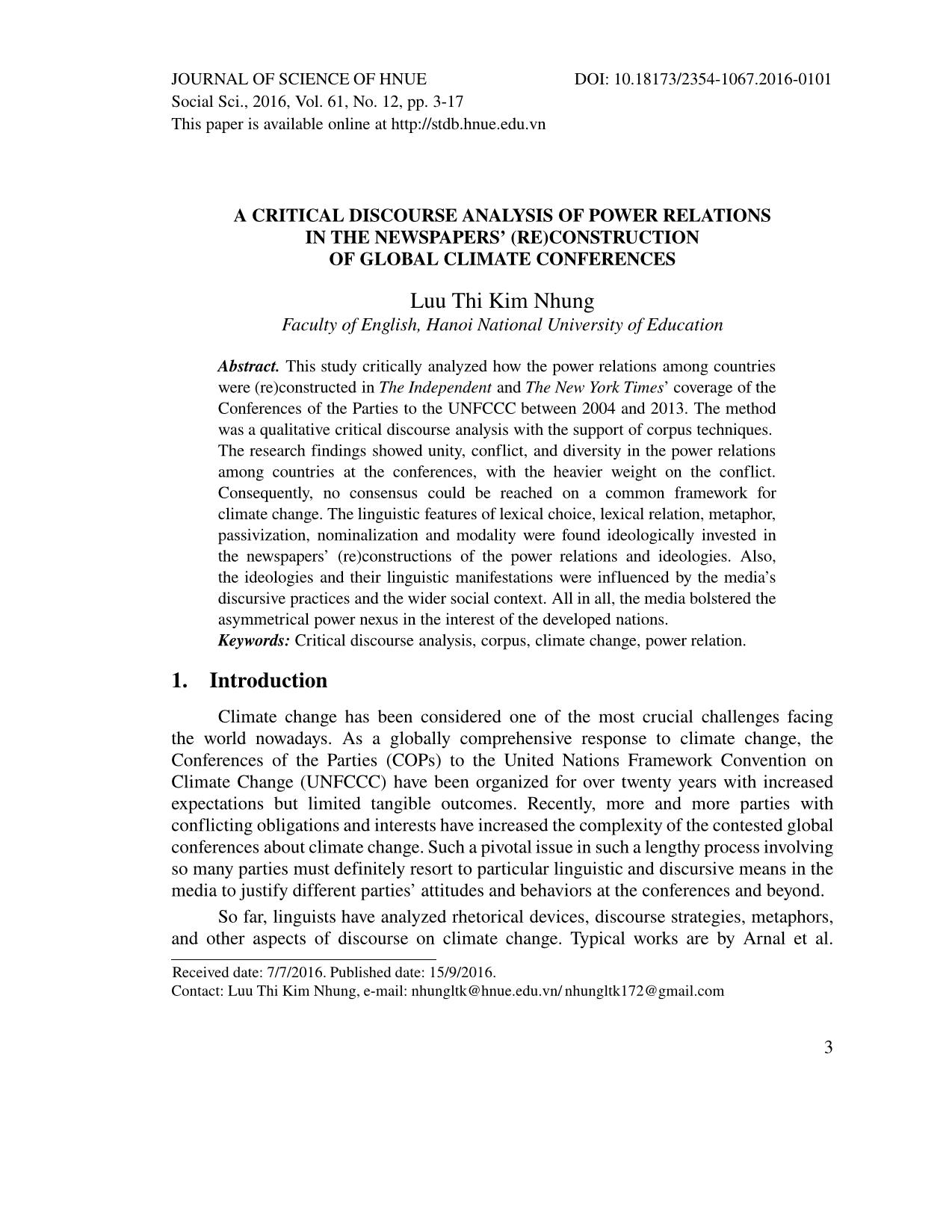
Trang 1
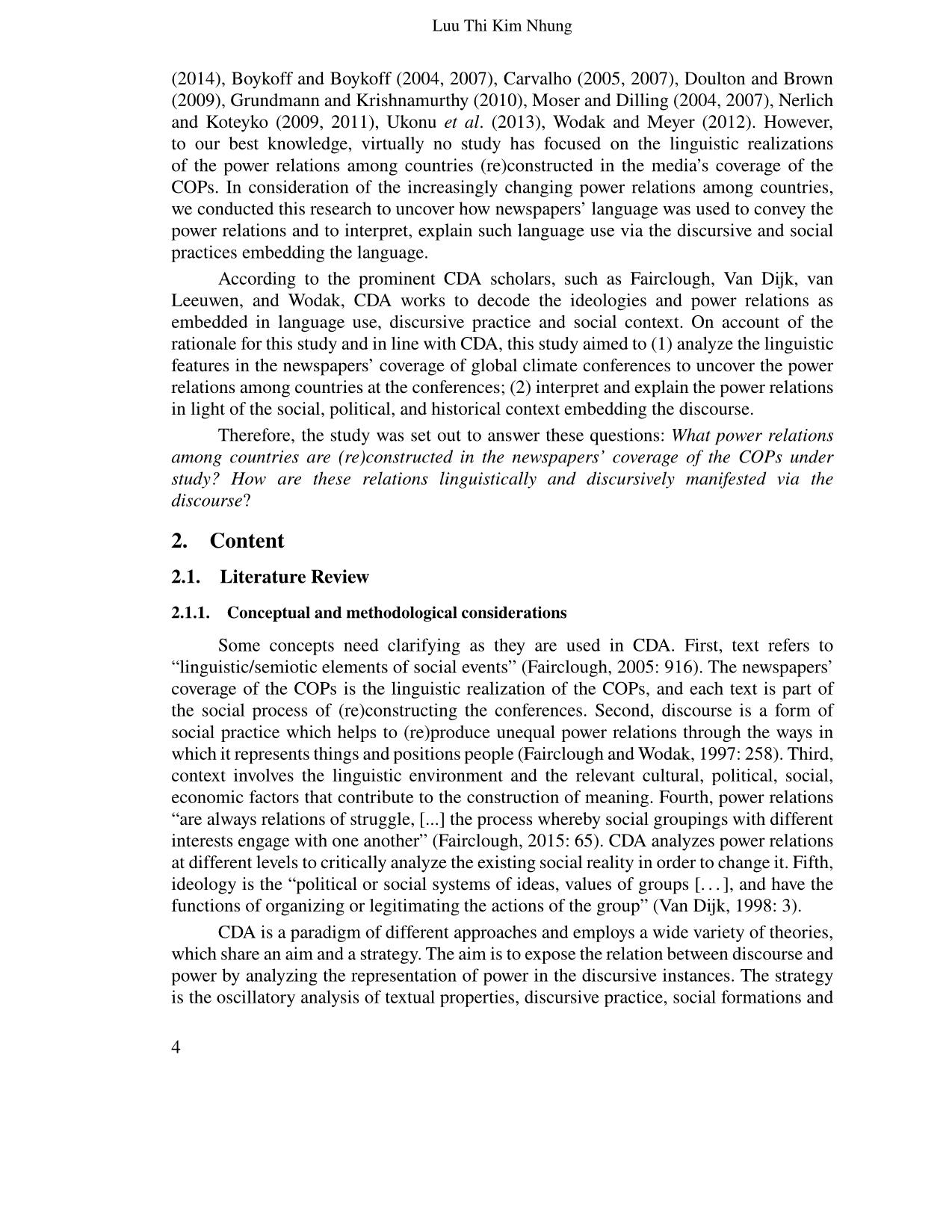
Trang 2
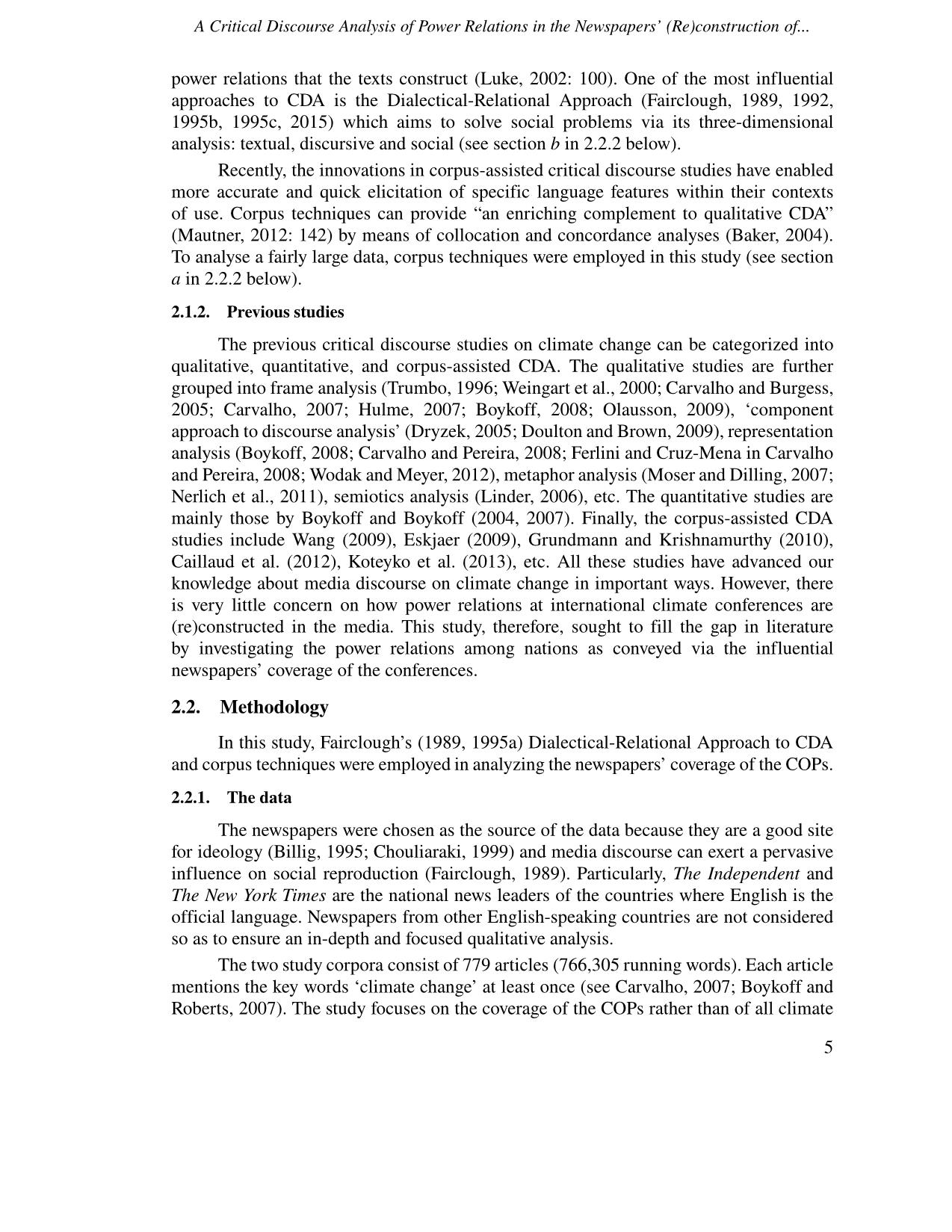
Trang 3
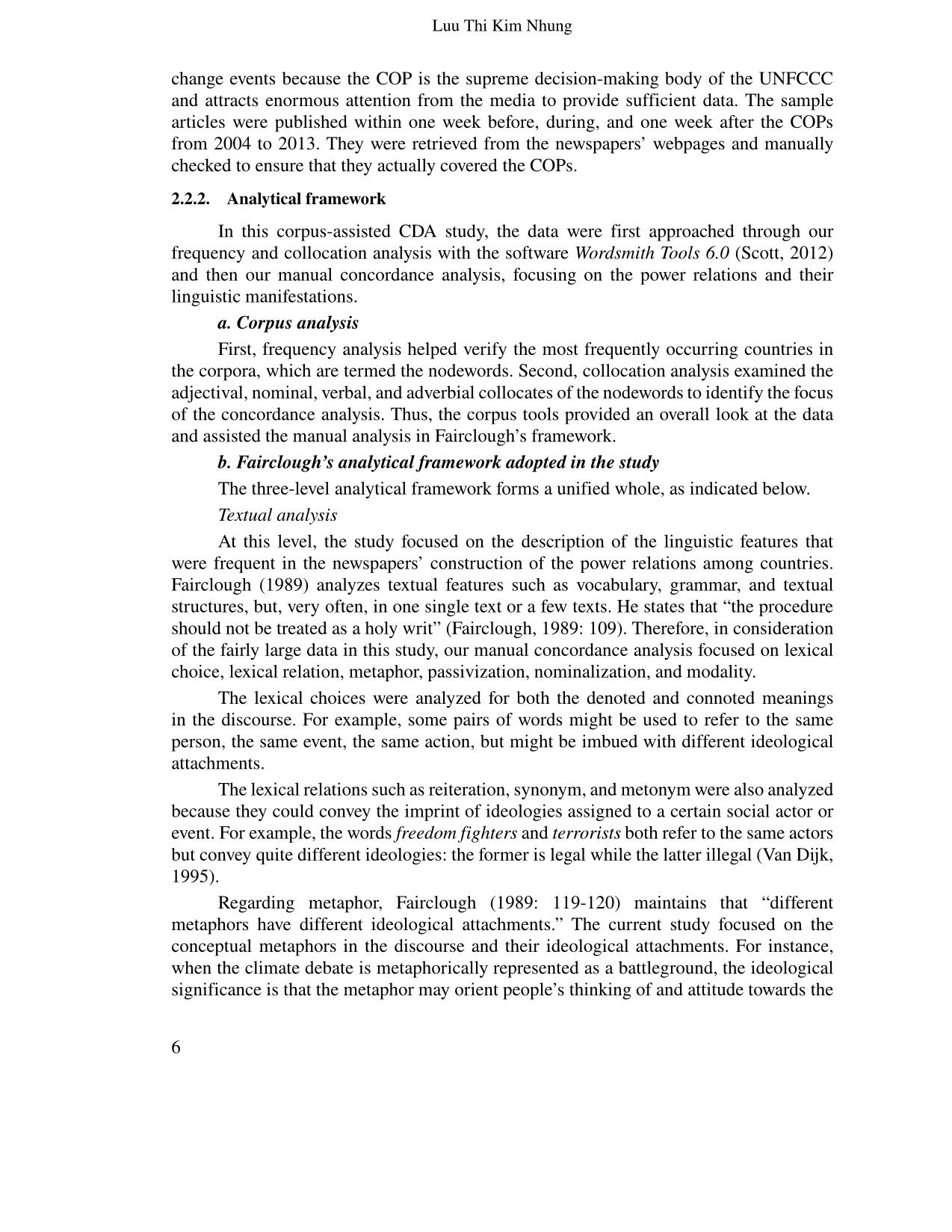
Trang 4
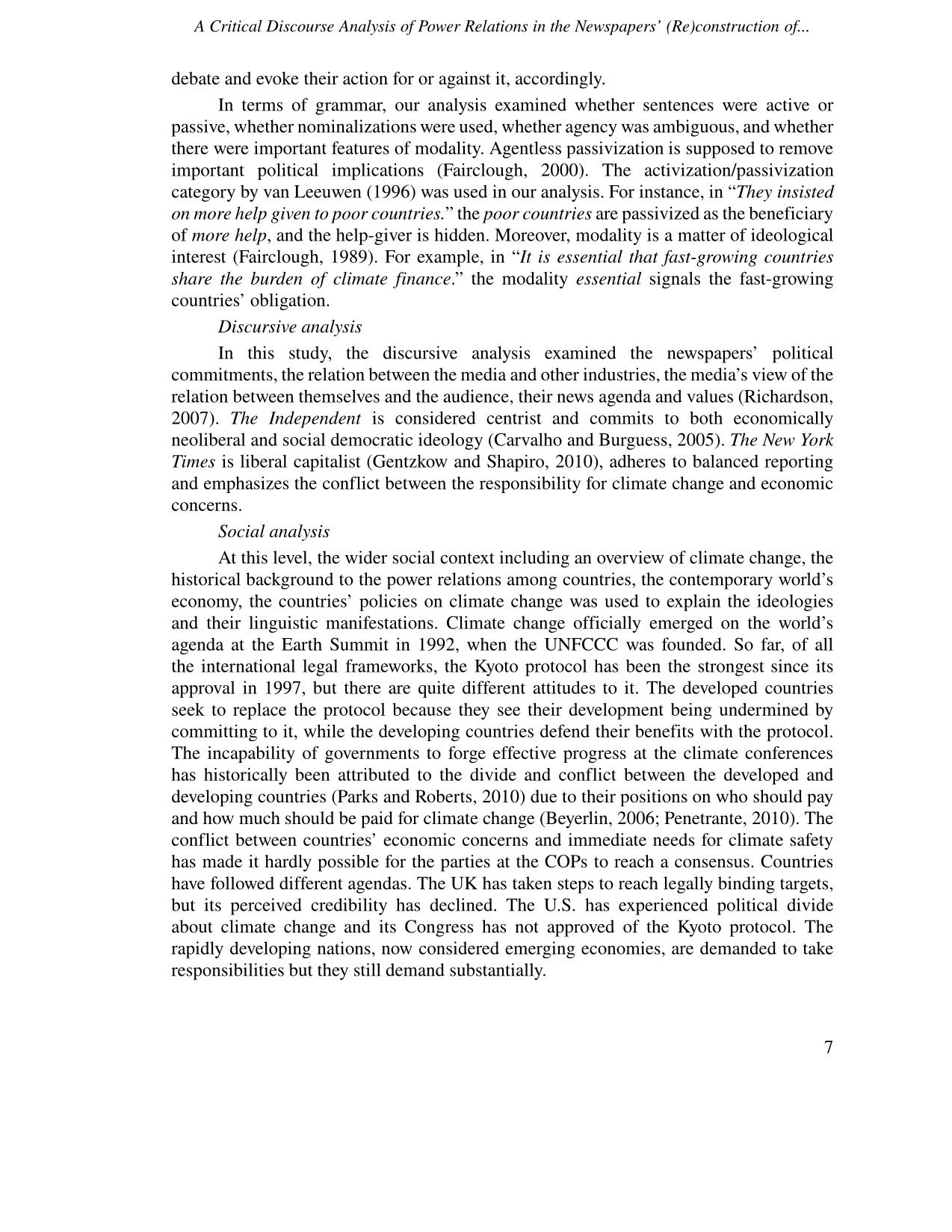
Trang 5
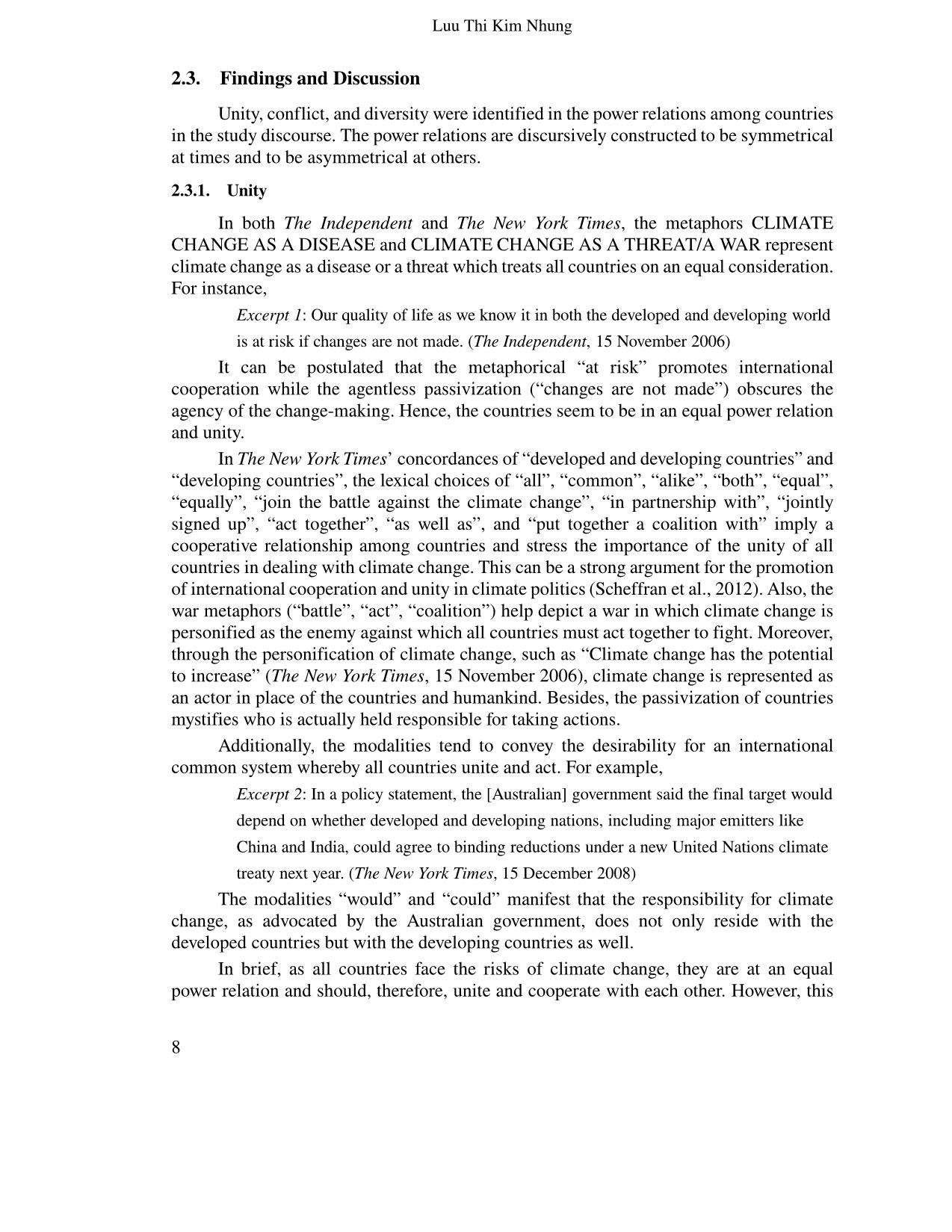
Trang 6
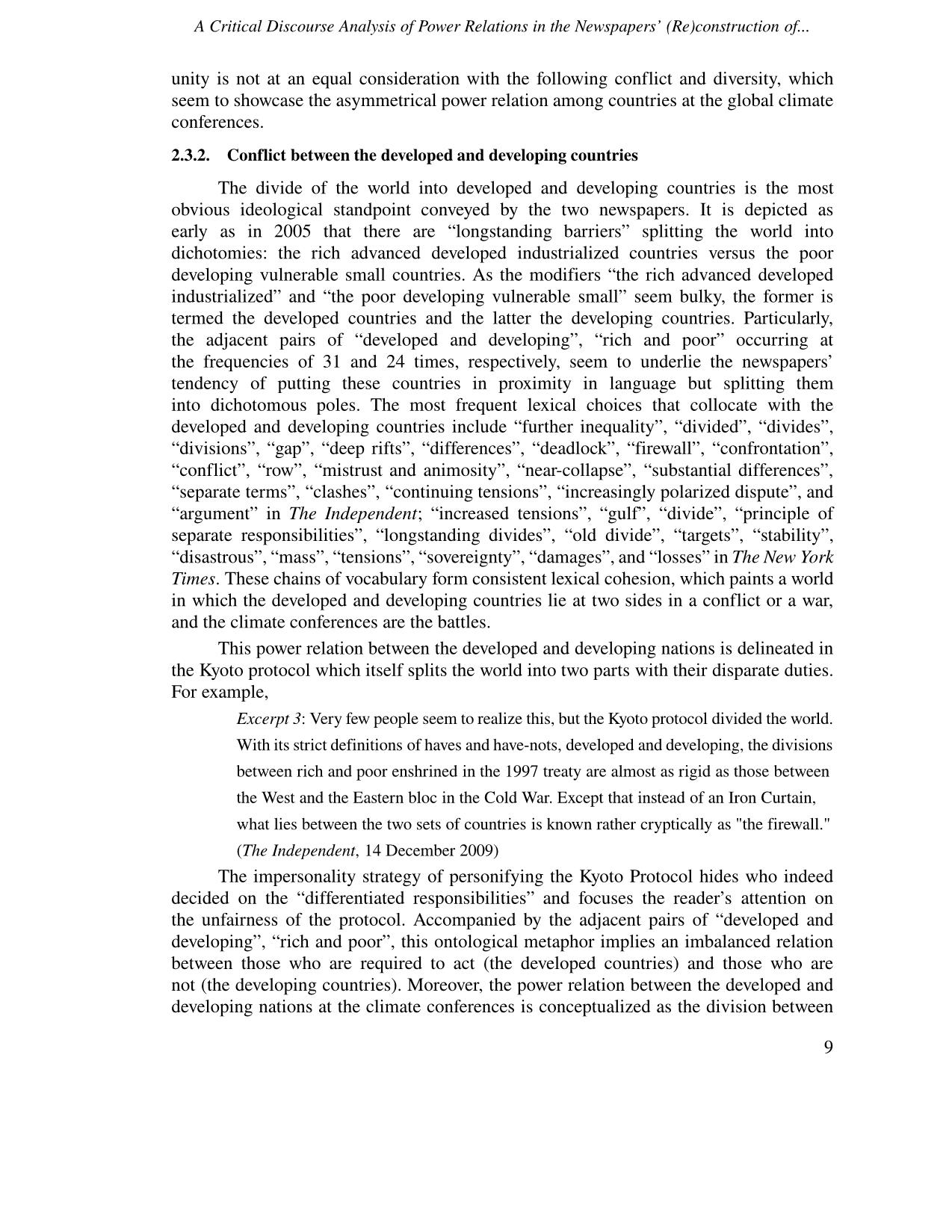
Trang 7
Tóm tắt nội dung tài liệu: A critical discourse analysis of power relations in the newspapers’ (re)construction of global climate conferences
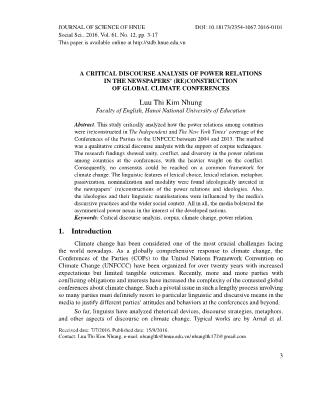
ical discourse studies on climate change can be categorized into qualitative, quantitative, and corpus-assisted CDA. The qualitative studies are further grouped into frame analysis (Trumbo, 1996; Weingart et al., 2000; Carvalho and Burgess, 2005; Carvalho, 2007; Hulme, 2007; Boykoff, 2008; Olausson, 2009), ‘component approach to discourse analysis’ (Dryzek, 2005; Doulton and Brown, 2009), representation analysis (Boykoff, 2008; Carvalho and Pereira, 2008; Ferlini and Cruz-Mena in Carvalho and Pereira, 2008; Wodak and Meyer, 2012), metaphor analysis (Moser and Dilling, 2007; Nerlich et al., 2011), semiotics analysis (Linder, 2006), etc. The quantitative studies are mainly those by Boykoff and Boykoff (2004, 2007). Finally, the corpus-assisted CDA studies include Wang (2009), Eskjaer (2009), Grundmann and Krishnamurthy (2010), Caillaud et al. (2012), Koteyko et al. (2013), etc. All these studies have advanced our knowledge about media discourse on climate change in important ways. However, there is very little concern on how power relations at international climate conferences are (re)constructed in the media. This study, therefore, sought to fill the gap in literature by investigating the power relations among nations as conveyed via the influential newspapers’ coverage of the conferences. 2.2. Methodology In this study, Fairclough’s (1989, 1995a) Dialectical-Relational Approach to CDA and corpus techniques were employed in analyzing the newspapers’ coverage of the COPs. 2.2.1. The data The newspapers were chosen as the source of the data because they are a good site for ideology (Billig, 1995; Chouliaraki, 1999) and media discourse can exert a pervasive influence on social reproduction (Fairclough, 1989). Particularly, The Independent and The New York Times are the national news leaders of the countries where English is the official language. Newspapers from other English-speaking countries are not considered so as to ensure an in-depth and focused qualitative analysis. The two study corpora consist of 779 articles (766,305 running words). Each article mentions the key words ‘climate change’ at least once (see Carvalho, 2007; Boykoff and Roberts, 2007). The study focuses on the coverage of the COPs rather than of all climate 5 Luu Thi Kim Nhung change events because the COP is the supreme decision-making body of the UNFCCC and attracts enormous attention from the media to provide sufficient data. The sample articles were published within one week before, during, and one week after the COPs from 2004 to 2013. They were retrieved from the newspapers’ webpages and manually checked to ensure that they actually covered the COPs. 2.2.2. Analytical framework In this corpus-assisted CDA study, the data were first approached through our frequency and collocation analysis with the software Wordsmith Tools 6.0 (Scott, 2012) and then our manual concordance analysis, focusing on the power relations and their linguistic manifestations. a. Corpus analysis First, frequency analysis helped verify the most frequently occurring countries in the corpora, which are termed the nodewords. Second, collocation analysis examined the adjectival, nominal, verbal, and adverbial collocates of the nodewords to identify the focus of the concordance analysis. Thus, the corpus tools provided an overall look at the data and assisted the manual analysis in Fairclough’s framework. b. Fairclough’s analytical framework adopted in the study The three-level analytical framework forms a unified whole, as indicated below. Textual analysis At this level, the study focused on the description of the linguistic features that were frequent in the newspapers’ construction of the power relations among countries. Fairclough (1989) analyzes textual features such as vocabulary, grammar, and textual structures, but, very often, in one single text or a few texts. He states that “the procedure should not be treated as a holy writ” (Fairclough, 1989: 109). Therefore, in consideration of the fairly large data in this study, our manual concordance analysis focused on lexical choice, lexical relation, metaphor, passivization, nominalization, and modality. The lexical choices were analyzed for both the denoted and connoted meanings in the discourse. For example, some pairs of words might be used to refer to the same person, the same event, the same action, but might be imbued with different ideological attachments. The lexical relations such as reiteration, synonym, and metonymwere also analyzed because they could convey the imprint of ideologies assigned to a certain social actor or event. For example, the words freedom fighters and terrorists both refer to the same actors but convey quite different ideologies: the former is legal while the latter illegal (Van Dijk, 1995). Regarding metaphor, Fairclough (1989: 119-120) maintains that “different metaphors have different ideological attachments.” The current study focused on the conceptual metaphors in the discourse and their ideological attachments. For instance, when the climate debate is metaphorically represented as a battleground, the ideological significance is that the metaphor may orient people’s thinking of and attitude towards the 6 A Critical Discourse Analysis of Power Relations in the Newspapers’ (Re)construction of... debate and evoke their action for or against it, accordingly. In terms of grammar, our analysis examined whether sentences were active or passive, whether nominalizations were used, whether agency was ambiguous, and whether there were important features of modality. Agentless passivization is supposed to remove important political implications (Fairclough, 2000). The activization/passivization category by van Leeuwen (1996) was used in our analysis. For instance, in “They insisted on more help given to poor countries.” the poor countries are passivized as the beneficiary of more help, and the help-giver is hidden. Moreover, modality is a matter of ideological interest (Fairclough, 1989). For example, in “It is essential that fast-growing countries share the burden of climate finance.” the modality essential signals the fast-growing countries’ obligation. Discursive analysis In this study, the discursive analysis examined the newspapers’ political commitments, the relation between the media and other industries, the media’s view of the relation between themselves and the audience, their news agenda and values (Richardson, 2007). The Independent is considered centrist and commits to both economically neoliberal and social democratic ideology (Carvalho and Burguess, 2005). The New York Times is liberal capitalist (Gentzkow and Shapiro, 2010), adheres to balanced reporting and emphasizes the conflict between the responsibility for climate change and economic concerns. Social analysis At this level, the wider social context including an overview of climate change, the historical background to the power relations among countries, the contemporary world’s economy, the countries’ policies on climate change was used to explain the ideologies and their linguistic manifestations. Climate change officially emerged on the world’s agenda at the Earth Summit in 1992, when the UNFCCC was founded. So far, of all the international legal frameworks, the Kyoto protocol has been the strongest since its approval in 1997, but there are quite different attitudes to it. The developed countries seek to replace the protocol because they see their development being undermined by committing to it, while the developing countries defend their benefits with the protocol. The incapability of governments to forge effective progress at the climate conferences has historically been attributed to the divide and conflict between the developed and developing countries (Parks and Roberts, 2010) due to their positions on who should pay and how much should be paid for climate change (Beyerlin, 2006; Penetrante, 2010). The conflict between countries’ economic concerns and immediate needs for climate safety has made it hardly possible for the parties at the COPs to reach a consensus. Countries have followed different agendas. The UK has taken steps to reach legally binding targets, but its perceived credibility has declined. The U.S. has experienced political divide about climate change and its Congress has not approved of the Kyoto protocol. The rapidly developing nations, now considered emerging economies, are demanded to take responsibilities but they still demand substantially. 7 Luu Thi Kim Nhung 2.3. Findings and Discussion Unity, conflict, and diversity were identified in the power relations among countries in the study discourse. The power relations are discursively constructed to be symmetrical at times and to be asymmetrical at others. 2.3.1. Unity In both The Independent and The New York Times, the metaphors CLIMATE CHANGE AS A DISEASE and CLIMATE CHANGE AS A THREAT/AWAR represent climate change as a disease or a threat which treats all countries on an equal consideration. For instance, Excerpt 1: Our quality of life as we know it in both the developed and developing world is at risk if changes are not made. (The Independent, 15 November 2006) It can be postulated that the metaphorical “at risk” promotes international cooperation while the agentless passivization (“changes are not made”) obscures the agency of the change-making. Hence, the countries seem to be in an equal power relation and unity. In The New York Times’ concordances of “developed and developing countries” and “developing countries”, the lexical choices of “all”, “common”, “alike”, “both”, “equal”, “equally”, “join the battle against the climate change”, “in partnership with”, “jointly signed up”, “act together”, “as well as”, and “put together a coalition with” imply a cooperative relationship among countries and stress the importance of the unity of all countries in dealing with climate change. This can be a strong argument for the promotion of international cooperation and unity in climate politics (Scheffran et al., 2012). Also, the war metaphors (“battle”, “act”, “coalition”) help depict a war in which climate change is personified as the enemy against which all countries must act together to fight. Moreover, through the personification of climate change, such as “Climate change has the potential to increase” (The New York Times, 15 November 2006), climate change is represented as an actor in place of the countries and humankind. Besides, the passivization of countries mystifies who is actually held responsible for taking actions. Additionally, the modalities tend to convey the desirability for an international common system whereby all countries unite and act. For example, Excerpt 2: In a policy statement, the [Australian] government said the final target would depend on whether developed and developing nations, including major emitters like China and India, could agree to binding reductions under a new United Nations climate treaty next year. (The New York Times, 15 December 2008) The modalities “would” and “could” manifest that the responsibility for climate change, as advocated by the Australian government, does not only reside with the developed countries but with the developing countries as well. In brief, as all countries face the risks of climate change, they are at an equal power relation and should, therefore, unite and cooperate with each other. However, this 8 A Critical Discourse Analysis of Power Relations in the Newspapers’ (Re)construction of... unity is not at an equal consideration with the following conflict and diversity, which seem to showcase the asymmetrical power relation among countries at the global climate conferences. 2.3.2. Conflict between the developed and developing countries The divide of the world into developed and developing countries is the most obvious ideological standpoint conveyed by the two newspapers. It is depicted as early as in 2005 that there are “longstanding barriers” splitting the world into dichotomies: the rich advanced developed industrialized countries versus the poor developing vulnerable small countries. As the modifiers “the rich advanced developed industrialized” and “the poor developing vulnerable small” seem bulky, the former is termed the developed countries and the latter the developing countries. Particularly, the adjacent pairs of “developed and developing”, “rich and poor” occurring at the frequencies of 31 and 24 times, respectively, seem to underlie the newspapers’ tendency of putting these countries in proximity in language but splitting them into dichotomous poles. The most frequent lexical choices that collocate with the developed and developing countries include “further inequality”, “divided”, “divides”, “divisions”, “gap”, “deep rifts”, “differences”, “deadlock”, “firewall”, “confrontation”, “conflict”, “row”, “mistrust and animosity”, “near-collapse”, “substantial differences”, “separate terms”, “clashes”, “continuing tensions”, “increasingly polarized dispute”, and “argument” in The Independent; “increased tensions”, “gulf”, “divide”, “principle of separate responsibilities”, “longstanding divides”, “old divide”, “targets”, “stability”, “disastrous”, “mass”, “tensions”, “sovereignty”, “damages”, and “losses” in The New York Times. These chains of vocabulary form consistent lexical cohesion, which paints a world in which the developed and developing countries lie at two sides in a conflict or a war, and the climate conferences are the battles. This power relation between the developed and developing nations is delineated in the Kyoto protocol which itself splits the world into two parts with their disparate duties. For example, Excerpt 3: Very few people seem to realize this, but the Kyoto protocol divided the world. With its strict definitions of haves and have-nots, developed and developing, the divisions between rich and poor enshrined in the 1997 treaty are almost as rigid as those between the West and the Eastern bloc in the Cold War. Except that instead of an Iron Curtain, what lies between the two sets of countries is known rather cryptically as "the firewall." (The Independent, 14 December 2009) The impersonality strategy of personifying the Kyoto Protocol hides who indeed decided on the “differentiated responsibilities” and focuses the reader’s attention on the unfairness of the protocol. Accompanied by the adjacent pairs of “developed and developing”, “rich and poor”, this ontological metaphor implies an imbalanced relation between those who are required to act (the developed countries) and those who are not (the developing countries). Moreover, the power relation between the developed and developing nations at the climate conferences is conceptualized as the division between 9
File đính kèm:
 a_critical_discourse_analysis_of_power_relations_in_the_news.pdf
a_critical_discourse_analysis_of_power_relations_in_the_news.pdf

